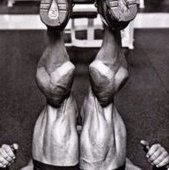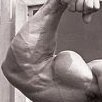Leaderboard
Popular Content
Showing content with the highest reputation on 09/01/2018 in all areas
-
AMAZING day today I shattered my Personal Best on my 5K time and am getting stronger in the GYM. as of this am I am now 201 pounds even and if this keeps up will be able to start adding size once I lean out to 185. todays run was like nothing I've ever experienced I was flying anf=d just couldn't loose my breath so I kept going at the 4k mark I hit a wall but powered through and destroyed my best time by almost 3 minutes2 points
-
Glucose is an indispensable metabolic fuel for the brain. For the reason that the brain is unable to synthesize glucose or store more than a few minutes supply as glycogen, it is critically dependent on a continuous supply of glucose from the circulation. "At normal (or elevated) arterial glucose concentrations, the rate of blood-to-brain glucose transport exceeds the rate of brain glucose metabolism. However, as arterial glucose levels fall below the physiological range, blood-to-brain glucose transport becomes limiting to brain glucose metabolism, and ultimately survival." - Hypoglycemia in Diabetes, Philip E. Cryer, Diabetes Care 26:1902-1912, 2003So what happens at various blood glucose levels?For practical purposes we can say that the body desires to maintain a stable glucose level in blood plasma of around 90 ng/dL. Blood glucose levels above that threshold are viewed as excess energy and this engenders a storage response via the pancreatic secretion of insulin. The hormone insulin removes glucose from blood plasma until levels return to 90ng/dL at which point insulin ceases to be active. Below that insulin triggering blood glucose threshold of 90ng/dL, down to about 70ng/dL, there is insufficient circulating energy and therefore the hormone glucagon is released to catabolize stored energy and make it available to the brain and body. Physical activity or energy demanding activity without the presence of circulating glucose or concurrent intake of food requires stored energy. Activity is the catalyst that drives the blood glucose level below 90ng/dL. Below 70ng/dL of glucose in blood plasma the body becomes concerned and because the brain is a critical organ and needs glucose, this threshold is considered critical. The hormone epinephrine (adrenaline) is released at this stage in order to trigger a quick release of stored energy to get blood glucose levels back to normal.The body when it is in this emergency state will burn anything for fuel and muscle can be catabolized. It is best to avoid this state.When you diet you can not lose fat in the presence of the hormone insulin. You want to have the hormone glucagon active and this requires that your blood glucose levels be between 70ng/dL and 90ng/dL. Glucagon acts to free up stored energy by signaling the adipocytes to activate Hormone-sensitive lipase which converts triglycerides into free fatty acids. Hormone-sensitive lipase is a vital component of fat mobilization and is a positively active force in the presence of glucagon and inhibited in the presence of insulin.Fatty acids have very low solubility in the blood however serum albumin, binds free fatty acids, and thereby increases their effective solubility by a factor of about 1000. Serum albumin transports fatty acids to organs such as muscle and liver for oxidation and this happens when blood sugar is low.So what is the minimal amount of glucose needed to trigger insulin & why again is insulin bad?From the textbook Biochemical and Physiological Aspects of Human Nutrition, Stipanuk et al. ed. 2000 Insulin ...is secreted in response to changes in circulating glucose; a change of as little as 2mg/100ml of plasma can be detected by the pancreas. Insulin release can also be stimulated in response to certain amino acids in the circulation. Other important signals for insulin secretion include gut hormones and nervous stimulation. - p395 In adipose tissue insulin increases fatty acid uptake and triacylglycerol storage via increases in lipoprotein lipase activity, and at the same time decreases lipolysis by decreasing hormone-sensitive lipase activity. The latter may be one of insulin's strongest actions because it occurs at very low insulin levels and effectively lowers the levels of free fatty acids in the circulation thereby decreasing there utilization as fuel. - p396 Is there way to minimize glucose's influence?Again from the textbook Biochemical and Physiological Aspects of Human Nutrition, Stipanuk et al. ed. 2000 Soluable viscous polysaccharides [certain fibers] can delay and even interfere with the absorption of nutrients... Positive benefits of delayed nutrient absorption include an improvement of glucose tolerance and a lowering of serum cholesterol levels. Delayed absorption of carbohydrates results in a lower postprandial (following a meal) glucose level. In general the more viscous the fiber the greater the effect on blood glucose. This is similar to the effect seen with eating several small meals rather than one large meal. When glucose is absorbed in small amounts over an extended period, such as seen with viscous fibers, the insulin response is attenuated (Pick, et al. (1996) Oat bran concentrate bread products improve long term control of diabetes: A pilot study J. Am Diet Assoc 96:1254-1261) ... Viscosity of the polysaccharides and their ability to form gels in the stomach appear to slow gastric emptying. This in turn results in a more uniform presentation of the meal to the small intestine for absorption. [Poorly soluble fibers that do not form gels such as wheat and cellulose have little effect...unlike those that do which include guar gum, pectin, psyllium, oat bran.] - p146. 147 A Practical ExperimentFor two days I used my glucose monitor to check my blood glucose after ingestion of coffee. Black coffee w/ no additives = zero rise in glucose Black coffee w/ Stevia = a 2 point rise in glucose Black coffee w/ Splenda = a 5 - 8 point rise in glucose. Coffee w/ Splenda & generic Coffee Mate creamer = 15+ point rise in glucose Coffee w/ Splenda & 2% Lactose free Milk = 17+ point rise in glucose So for me the caffeine in a cup of coffee does not effect blood glucose BUT the additives sure as heck do!How do you reduce the rise in blood glucose w/ these additives (besides the obvious)? ....add FIBER.So ingesting 2 grams of Psyllium Husk powder just prior to drinking Coffee w/ Splenda & Coffee Mate creamer resulted in only a 4 point rise in blood glucose. WOW!So how does Growth Hormone fit in to all of this?First recognize that there will be periods of time post meal where blood glucose and thus insulin will be elevated. There is no fat loss during this time and Growth Hormone will not be effective during these periods.With this recognition it makes sense to reduce the amplitude and area under the curve (in graph-type language) of insulin spikes. Meals should be constructed with both the glycemic index of foods in mind and the total glycemic load of the meal. Fiber should be used to reduce blood glucose levels.With this recognition it makes sense to maximize the time period when glucagon is active. That requires insulin to return to baseline quickly after a meal and a sufficient period of time between meals to allow glucagon to have an effective impact. Activity between meals as well as the presence of GH will have positive impacts on fat loss.The reason it is necessary to write about everything in this post is so that you understand how easy it is to waste Growth Hormones fat loss potential and what one must do to maximize GH's fat loss power.Too often someone will use GH and admit that their diet wasn't very good. That negates much of GH's positive impact on fat loss.I also wanted to put GH into a proper context which sadly is often lacking in people who hope for better body attainment. The things I have barely touched on are of utmost importance and make up the backbone of a sound fat loss protocol.GH can be a very useful adjunct to a properly constructed protocol which focuses on food intake with proper hormonal impact and sustained activity level.Use of GHFrom other posts we understand that GH has a dual role to play in a diet. It can increase the rate of fat loss and it can help inhibit the breakdown of muscle. So you want to administer GH in smaller amounts, you want to have off periods (i.e. time when GH is not active) so that the intracellular pathways can reset and you want to maximize the frequency of administration.So we need to understand the impact of GH dose on levels of GH in plasma to set a schedule. We can extrapolate from the chart from the GH study posted above. Assuming a linear relationship (since 7.5ius were active for 12 hours & 15ius for 24 hours) we can assume that a dose of 2ius of synthetic GH administration will elevate GH in plasma for 3.2 hours. If we need about 4 hours off (we can probably round down to 3.8 hours) we can dose 2ius of GH every 7 hours. For ease of fitting a dosing schedule into our lives we can round up to 8 hours and say that we can dose 2ius three times a day spaced out by 7-8 hours.Since GH isn't effective for fat loss in the presence of insulin we probably want the meals that have the biggest impact on blood glucose and thus insulin to be ingested during the time GH is not active. After that meal is digested and insulin rises and then falls back to 90ng/dL we can administer GH and be confident it will have a positive impact on our overall fat loss protocol.1 point
-
Hello all, I am your board Physical Therapist, and i've contributed over the many years to helping with best advice and principles given for injury prevention, rehabilitation, facilitation, and referrals onwards to anyone who is in need of help or direction. Should you have an injury (as most of us do at some point) or a question about a potential injury, I kindly ask you that you create a new topic with some information in mind, stated below, that would help me help you as best as I can! 1) Nature of injury How did it happen? Was there a mechanism of injury or was it progressive onset? How long has this been going on for? 2) Describe your symptoms Constant? Comes and goes? Sharp/dull/ache/burning? Does it refer down your arms/legs? 3) Past history? Any relevant history of previous injury to that area? Familial history? 4) What makes it worse? What makes it better? Moving arm up over head? twisting? Washing your hair? Or how about adding ice and heat/hot tub makes it better? 5) Scans already done/in progress? Have you had an xray/ultrasound/MRI already done? How long ago? Do you have a copy of the report you could upload a pic so it can be read and understood and properly educated on? 6) Goals? Back to same lifting? Specific sport or hobby? Maybe you want to play guitar again and can't or play with your kids? 7) Medications? Current medications taking for this, or general health (heart, blood pressure, cholesterol, diabetes, etc). Knowing your cycle, if on, helps as well and for how long. Armed with this general information, it's much "easier" to help formulate a physical suggestive diagnosis and help guide you towards recovery. Kepe in mind, this does not replace visiting your local Physical Therapist and/or Medical Doctor, and if you need proper help with potential medication or other more extensive work done in a clinic you should ALWAYS do that. With that, let's all be happy and healthy and injury free!1 point
-
lol... I tired my double edge razor on my head after I got good on my face with it.. nope... tons of nicks. Might be easier on your chest because you can see what your doing. I lady at a high end shave shop told me and my wife she uses double edge/bradger bursh etc on her legs and nothing else.1 point
-
Been using Genetec for a while now exclusively. Great lab and products. Rep is awesome. Fair prices. They are the real deal and one of the top UGL in Canada.1 point
-
I use a Braun Series 7 shaver. If the hair is long i use the little slide out trimmer to cut the hair down and then use the regular razor part of it for the close shave. Works well for me and been using it for years. I have the clean and charge station so i can clean it every so often.1 point
-
1 point
-
1 point
-
1 point
-
Any good 200 mg primo I tried was like injecting battery acid. 100 mg primo will had a tiny bit. but we all react differently, so yours might be fine.1 point
-
1 point
-
1 point
-
1 point
-
Here's what you need to know... Many lifters consider squats to be the best exercise for building up the legs. Similarly, many lifters consider dips to be the best exercise for building up the front side of the upper body and their number one chest exercise. Going to or just below parallel on dips (upper arm parallel to the floor) will work the muscles effectively while sparing the joints. To progress the dip, use ring dips, countdowns, dead stops, and constant tension dips. Dips are the upper body equivalent of squats, both for better and for worse. For Better Many lifters consider squats to be the best overall lower body exercise, and rightfully so. Many massive thighs have been built by squats. Similarly, many consider dips to be the best exercise for building up the front side of the upper body and consider them to be their number one chest exercise, and rightfully so. Many massive chests have been built via tons and tons of dips. For Worse Many other lifters, especially those with pre-existing injuries, don't feel squats all that much in their quads and instead find that they piss off their knees and/or lower back. Similarly, many lifters find that dips piss off their shoulders, especially those with pre-existing injuries. Now What? So are squats and dips good exercises or bad exercises? The answer to that question depends on who you ask. Ask a guy with a good squatter's build, good hip mobility, and healthy joints if squats are good and he'll give you two thumbs up. But ask a guy with long femurs or tight hips, or someone with a significant lower back or knee injury, and he'll probably mumble a curse and change the subject. Similarly, ask a guy with jacked up shoulders or poor shoulder mobility, or a coach who primarily works with overhead athletes whose shoulders are delicate, and he'll probably give dips an emphatic thumbs down. It's likely, though, that you'd get the opposite response from a lifter with healthy shoulders and good shoulder mobility. If you have shoulder problems, poor shoulder mobility, or participate in overhead sports, I'd recommend cutting out dips in favor of different pressing variations, push-up variations, and landmine presses. But if you like dips and they don't bother your shoulders, here are some ways to make them safer and even more effective. Dip Form The form issues that often arise with dips are actually very similar to those that arise with squats and pertain mostly to depth and rep speed. We all know the depth issues with squatting. On one hand you have the guys that go way too heavy and end up squatting a mile high, while on the other hand you have the "ass to grass" zealots who feel that anything less than leaving an ass print on the floor is somehow cheating, even if going that low means jeopardizing your knees and lower back. The same goes for dips. Some guys will do partial reps and barely come halfway down in the name of adding more weight or cranking out more reps, while others will say you're a pussy unless you're burying your hands deep into your armpits on every rep. A little moderation goes a long way with both exercises, and going to (or just below) parallel – meaning the top of the thigh parallel to the floor for squats and the upper arm parallel to the floor for dips – is probably the best recommendation for the majority of lifters in regards to working the muscles effectively while sparing the joints. As for rep speed, again, a little moderation goes a long way. With squats, people tend to experience knee pain when they dive bomb the eccentric and bounce out of the hole. With dips, people tend to rush the reps and end up with their shoulders coming too far forward as the set goes on, which puts them in a precarious position. Control each rep. The Devil is in the Dose Bodyweight squats are very different from heavy barbell squats. Even people with lower back and knee issues may be able to tolerate bodyweight or even light squats just fine, but when the load gets heavy, it's another story altogether. The game also changes as you get stronger. Your joints might feel fine doing five rep squats when your 5RM is 185, but as you get stronger and your 5RM starts creeping up, you may find that your joints start to revolt and you need to start lightening the load and using more moderate rep ranges. The same goes for dips. I used to do heavy dips in the 3-5 rep range and loved them, but I found that as I started getting a lot stronger at them they started to bug my shoulders. If I keep the load moderate and work in the 8-20 rep range, my shoulders are just fine. The same can be said for volume. Someone may be able to tolerate doing an exercise once a week but find that if they increase to 2-4 times a week, it starts to be a problem. If some is good, more isn't necessarily better. This should be common sense, but the fitness world is often very black and white and likes to label exercises as either good or bad when most of the time it's really more a matter of programming. So rather than doing heavy weighted dips at the start of your upper body workouts, try doing them near the end of your workout after you've already done your heavy pressing. That way, you ensure that your shoulders are sufficiently warmed up. Additionally, you won't need to use as much weight as if you were doing them fresh. Cool Dip Variations I've already recommended that you should save dips for later in your upper body workouts and use moderate rep ranges. That's not to say you can't add weight, but keep the weight at something you can handle for at least eight reps rather than working in lower rep ranges. There are, however, a few different ways to up the ante beyond just adding weight. Ring Dips If dips are the upper body equivalent to squats, then I consider ring dips to be the upper body equivalent of front squats. Many lifters struggle at first holding the bar on front squats and consequently write off the exercise without giving it much of a chance. If they stick it out and practice front squatting for a few sessions, they quickly realize that the learning curve is actually quite fast. And once they get the hang of it, they can still handle sizeable loads (usually about 80-85% of what they can back squat). Better yet, they find that front squats target their quads better while also being easier on the lower back and knees. Rings dips are much the same. I don't care how good you are at dips, the first couple of times you do ring dips is going to be humbling. You might not even be able to do them at all and you'll be quivering like you've got Parkinson's. Most people who are good at regular dips, though, will quickly adjust to ring dips within three to four sessions of consistent practice. And once they get used to the rings, most people will end up being able to handle nearly as much weight and crank out nearly as many reps as they can do on the dip bars. Moreover, many people find that ring dips are far easier on the shoulders and they feel them even more in their chest: a win-win. The key to learning ring dips is to practice them at the start of your workout when you're fresh because trying to adjust to the instability of the rings is exponentially harder when you're already fatigued.. Pairing ring dips with pull-ups/inverted rows/hip thrusts is a combination exercise I created to work the back, glutes, and hamstrings simultaneously. For people who like to do full body workouts, this pairing works really well after doing a heavy knee-dominant exercise like squats or Bulgarian split squats to finish off the rest of the body in a hurry. From a muscle-building standpoint, this pairing works well because the two exercises focus on different parts of the body so they don't negatively impact one another. From a logistical standpoint, it works great because the ring height ends up being the same for each exercise so you don't have to fumble around with adjusting them. You can do both exercises as straight sets, or if you really want to punish yourself, you can try a countdown as I showed in the video above. Start by doing 10 reps of each exercise, then 8, then 6, then 4, then 2, all in succession with minimal rest in between. In total, it comes out to 30 reps of each exercise. If that's too much, start at six or eight and work down from there. Constant Tension Reps Here you'd just do regular dips, only you stop just short of locking out your elbows at the top to keep constant tension on the chest. This method works great at the end of a session where you'd use higher rep ranges and perform the reps with a little faster tempo than normal without getting sloppy. I don't have a video of these because I'd rather not have the YouTube form-police start giving me grief for not doing dips correctly, but trust me, they work incredibly well!1 point
-
I always take a cialis and Viagra for arm days, you should see the pump the arms get. Just have to be careful and not think anything dirty or look at the girls in the gym because the pump goes down south very quick!1 point
-
1 point
-
To be fair... negative reviews are a part of a fair and balanced conversation. I think it offers transparency and honesty. And any good lab shouldn't be afraid of it. The rep offered to discuss, or clarify, or resolve the issue.. the person with the review may be like me... at work and may be able to respond right now.. but at any moment my boss could walk in and take me to do something. I could be gone 10 minutes, or the whole day. I personally get a little suspect reading a thread where all the reviews are all popcorn and bubblegum. Deleting his comments are a little extreme and assumes that we as readers are idiots can't see through the trees. Yea , I get it that every board has a lab or 2 behind them and it's not too hard to figure out who they are by how hard admins come down on criticisms. And usually the biggest bashers are yes.. behind other labs.. bit for many of us who are trying to make the best decisions with our hard earned money, we aren't playing the political game. We just want the best gear at the best price. So all things being equal, fairness means reading things one may not like, agree with. For example, a lab got hammered last year/ early this year in numerous places. Before then they had a stellar reputation. So at the time they were my #1 lab to try out. Yes, I was disappointed to read what I read and was somewhat trepidatious... but I ended up ordering from them anyway. They have been excellent. So while I respect the fact that reputations can be ruined by irresponsible posts, I think it's important for us readers to be able to digest the entire conversation. Those of us buyers have no skin in the game and will likely buy where they want anyway.1 point
-
1 point
-
we are not stopping nouveau the updated version is officially domestrically produced,as is the raw material. Nothing form china anymore and is on par to government standards for the pharma industry of canada Previous nouveau was produced here but raw came from china1 point
-
that part has been confirmed a few times. not worried about that but i can do a test directly because no one likes taureaus name lol1 point
-
1 point
-
A complete lab, with wide range of products. Great results, very professional rep, great customer service & quick communication! ? Overall A+1 point
This leaderboard is set to Toronto/GMT-04:00










